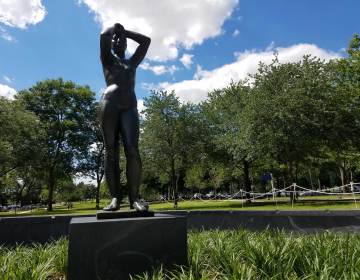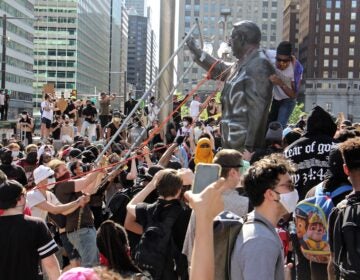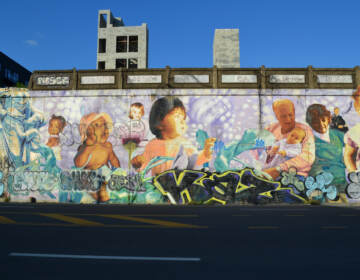First new sculpture in 70 years for Philly’s 30th Street Station
Amtrak built a wall on wheels to accommodate Virginia Maksymowicz’s “Tools of the Trade,” honoring hand labor in the national rail system.
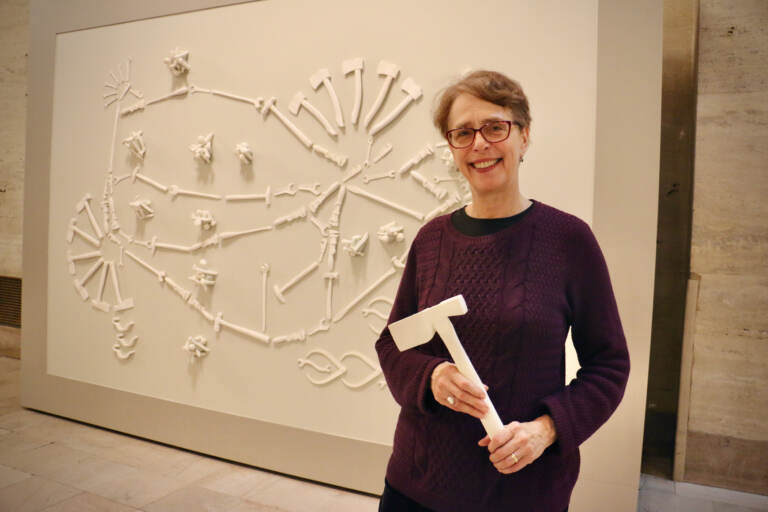
Virginia Maksymowicz holds one of the cast-plastic tools she created for her sculpture, ''Tools of the Trade,'' now installed in the North Waiting Room of William H. Gray III 30th Street Station. (Emma Lee/WHYY)
The last time 30th Street train station in Philadelphia got a new public sculpture was in 1952, when Walker Hancock’s Pennsylvania Railroad War Memorial was installed in the main hall, honoring the 1,307 Pennsylvania Railroad employees who died in World War II.
Now, 70 years later, the station has a new sculpture.
“Tools of the Trade” is a large (14’x10’) wall sculpture depicting an abstract map of the United States with a network of rail lines. Those routes are made from peen hammers and wrenches lined end-to-end, mountain ranges are denoted by piles of spikes, and main rail hubs like Chicago and Seattle are made of fanned hatchets.
Artist Virginia Maksymowicz cast them from vintage tools in a porous white polyurethane that makes them look like the bones of a skeleton.
“The structure of this national train system is, in a way, a skeleton that ties the country together,” Maksymowicz said. “I wanted to use tools also to reflect the invisible work that happens all the time by the Amtrak employees.”
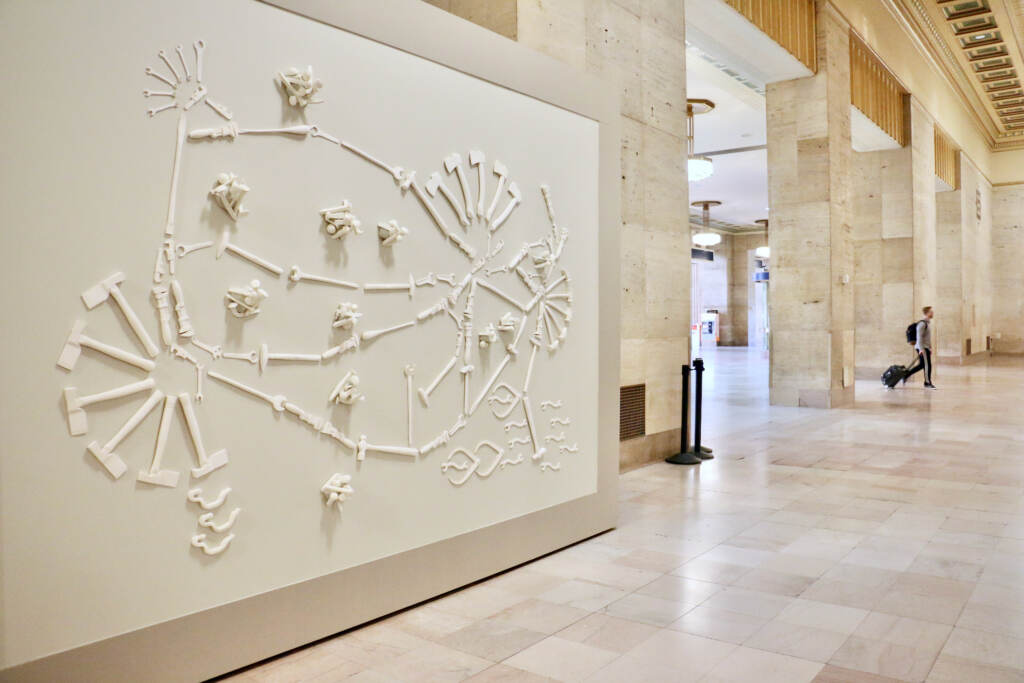
Maksymowicz pressed the vintage tools into silicone molds, which picked up chips in the iron and the wear of the handles. She wanted to highlight the intimacy of handwork that goes into building and running a rail system.
The artist used to spend a lot of time on trains when she commuted for 25 years on the Keystone service from her home in West Philadelphia to her job teaching at Franklin and Marshall College in Lancaster, Pa. She learned to appreciate that while trains and the systems they run on are massive technological beasts, they are ultimately moved by people.
“Even conductors. I saw conductors having to crawl under the train to pull things out,” Maksymowicz said. “Incredible amount of work. We as passengers just don’t see it.”
“There was this one [conductor] in particular, Curtis,” she said. “He would sit with all of us from Franklin and Marshall and we’d get into political debates, and debates about art. He’d tell us of his travels in France. At Christmas people would have a holiday party on the train. This might not happen on every run, but the Keystone, in particular, is pretty local.”
The interior of 30th Street Station is historically preserved, which means it cannot be altered without permission from the city’s Historical Commission. Amtrak could not modify the marble walls of the Art Deco building to add Maksymowicz’s tool map to the building.
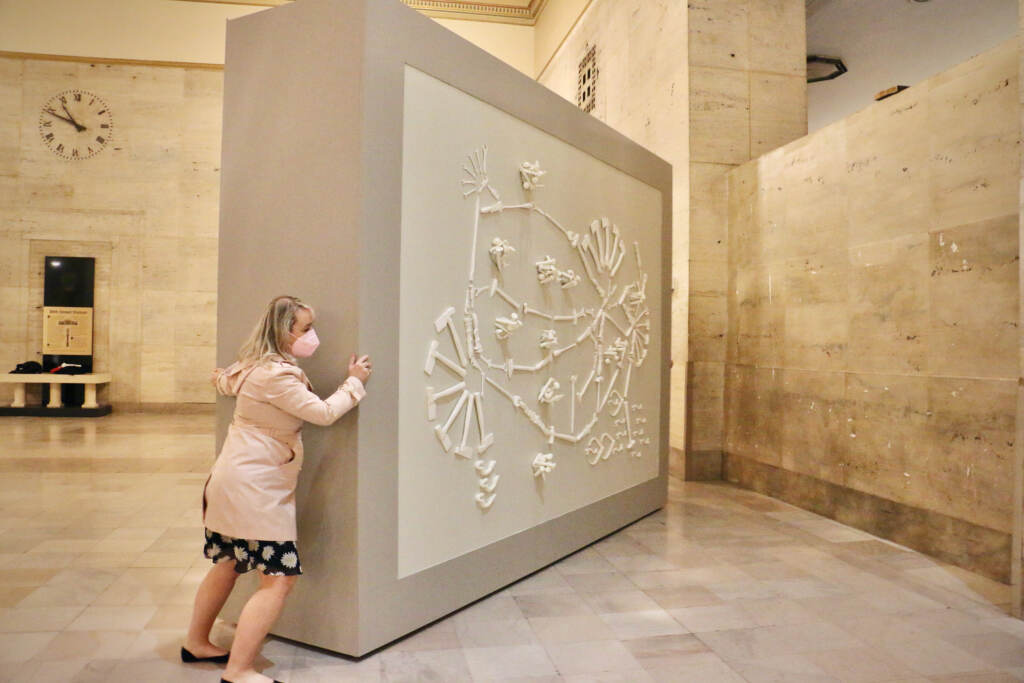
Instead, a large mobile wall was custom-built for the sculpture with rolling casters, constructed to fit neatly into a niche of the North Waiting Room.
“Tools of the Trade” can be flipped around, disappearing in the niche. Or, it can be rolled into another part of the station.
Amtrak originally commissioned Maksymowicz to make a photography-ready version of the tool map for its now-defunct onboard magazine The National. After pictures were taken for a print layout, she asked if the company would consider commissioning a “real” sculpture, not just a photo, for permanent placement in the station.
Amtrak’s Senior Manager of Major Stations, Scott Clinton, said the sculpture makes an appropriate addition to the North Waiting Room, which is itself waiting for a renovation.
“We have some preliminary designs that we’re working with, but we have not achieved what we call a 60% design,” Clinton said. “We just have some concepts and we’re working those through.”
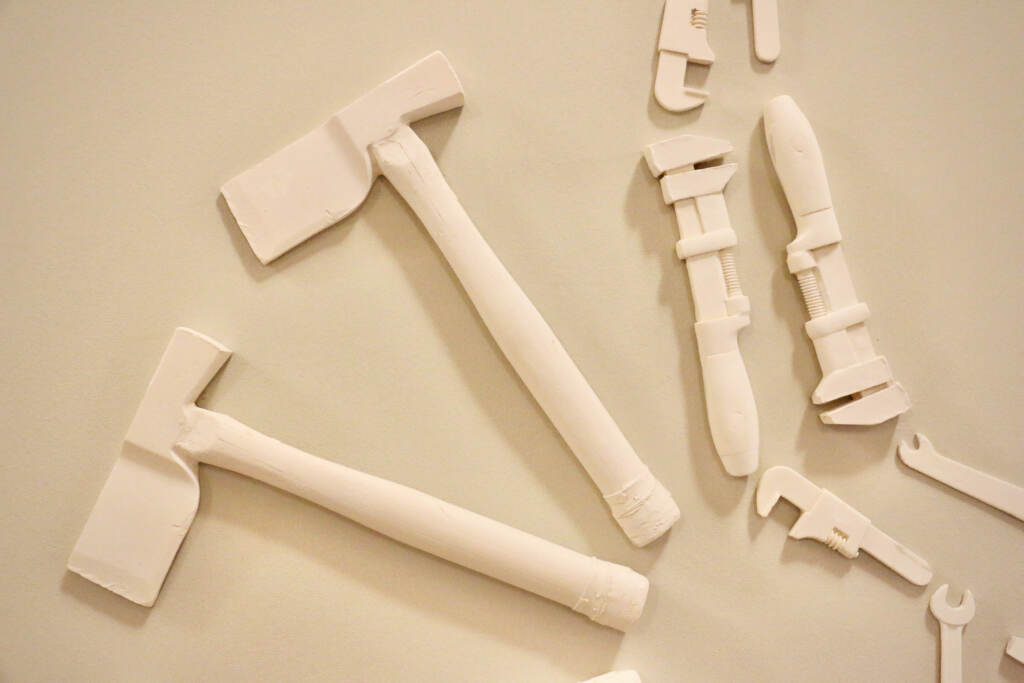
The North Waiting Room was originally built in the 1930s with benches to be used as the name suggested, but passengers preferred to wait in the main hall near the shops and escalators to the underground platforms. Ultimately the benches were moved to the main hall and the North Waiting Room became little more than a hallway to the bathrooms.
It’s also where the station’s original wall sculpture is located, a large relief called “The Spirit of Transportation,” built into the station in the 1930s, having been moved from Pennsylvania Railroad’s previous urban station at Broad Street near City Hall.
Clinton said Amtrak is currently considering how to better activate the North Waiting Room.
“There’s a lot of different ideas,” he said. “What’s important is that we highlight the beautiful esthetics of the building, but also allow for it to be as intuitive as possible so that people aren’t obliged to ask for directions when they’re looking for different functions of the station.”
There is no timeline, or a definitive plan, for the changes to the room. Maksymowicz hopes her “semi-permanent” sculpture on wheels can be part of its future.

Get daily updates from WHYY News!
WHYY is your source for fact-based, in-depth journalism and information. As a nonprofit organization, we rely on financial support from readers like you. Please give today.



